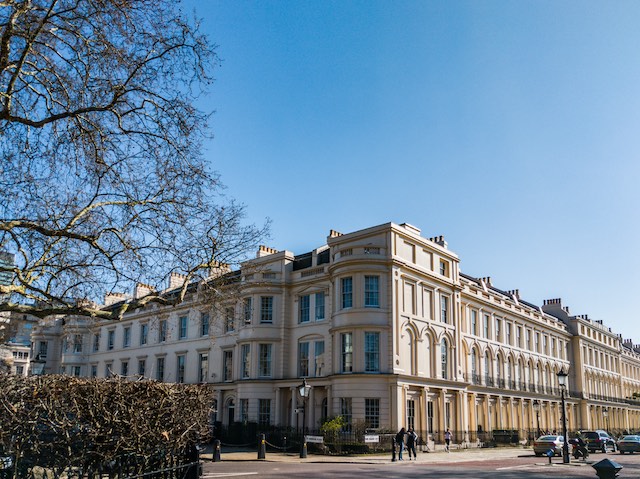Regent's Park Area Guide

The Regent’s Park is one of the best-known Royal Parks of London. The surrounding residential area, with its palatial terraces and unique architecture, is distinct. It’s no wonder these homes have long attracted literary artists, such as HG Wells.
It’s not hyperbole, either, to say that the neighbourhood is fit for royalty. In the 1530s, the land was acquired by Henry VIII. Then known as Marylebone Park, it was used as a hunting and forestry park, before being let out for small holdings. The redevelopment of the park was initially envisaged by the Prince Regent George IV, who recruited the architect John Nash. Nash, along with James and Decimus Burton, designed the park itself and the elegant lines of Stucco-fronted terraced houses that surround the upper circle. The grand plans were never completed as originally intended, but the neighbourhood remains a prime example of the period.
The Grade I listed park is made up of open parkland, popular for walking and running, as well as families playing and picnicking at the weekends. There are also several public gardens, including the famed Queen Mary’s Gardens in the Inner Circle, and formal Italian gardens. Blending the old with the new, there are also sports pitches, a boating lake and children’s playgrounds. With such a large span of open green space, it’s easy to forget for a moment that the oasis is so close to central London.
Properties in Regent’s Park
For those moving to Regent’s Park, its proximity to central London is certainly an attractive factor. It’s commutable by foot, though there are numerous Underground stations close by for a quick route into the City.
The properties themselves are also a big draw for those looking for a central London home. The grand terraced rows are highly coveted, with many of the buildings holding Grade I or Grade II listed status. Gloucester Gate, Cumberland Terrace, Cambridge Terrace, Sussex Place, among others, were designed by Nash and Decimus Burton between 1825 and 1880. With views out over the park itself, it’s no wonder that when one of these homes comes to market, they are acquired with haste.
The townhouses have been extensively renovated over the years. Behind the period features, it’s not uncommon to find the very latest modern inclusions, such as home gyms and cinema rooms.
When the park was originally created, there were nine villas, some of which remain standing as private residences. Nuffield Lodge, for example, has one of the largest gardens in central London, sitting on the edge of Regent’s Canal. Other villas have been demolished over the years, and have been replaced with new structures, such as the London Central Mosque. Between 1988 and 2004, a further six villas were added to the park, built by the Crown Estate. The villas were designed by architect Quinlan Terry, each representing a different style of classical architecture.
Family life in Regent’s Park
For those moving to Regent’s Park with children, it’s reassuring to note that there are numerous private schools and nurseries in the surrounding area. There is no shortage of extracurricular activities either. ZSL London Zoo, the world’s oldest scientific zoo, is within Regent’s Park and has various events running throughout the year.
Some of the best-known London attractions are located close to Regent’s Park too. Madame Tussauds and The Sherlock Holmes Museum are popular with local residents and tourists alike, and will pique the interests of curious children.
For families looking for a more cultural experience, Regent’s Park Open Air Theatre is worth a visit on warmer summer evenings. The programme is varied, with both classic and modern productions. In October, the art event Frieze London takes over Regent’s Park, and is a good opportunity to source new works of arts from around the world. The Royal Academy of Music Museum offers the chance to explore unique instruments and manuscripts.
It’s also an area that’s highly commutable. As well as the aforementioned Underground links, London Marylebone station is a short walk away with links to Buckinghamshire, Oxfordshire and beyond. It’s also not too far to travel to London Euston for national rail services, or to drive out of London on the A40. The area is also very walkable. With the canal, park and residential streets, it’s possible to get a bit of time out from the bustle of London life, by enjoying a stroll around the neighbourhood.
Shopping and eating
The central location of Regent’s Park means it’s surrounded on all sides by neighbouring communities with a lot to offer. Primrose Hill is to its north, just over the road from the zoo. As well as the green space of the hill itself, the area is home to numerous stylish boutiques and independent shops. It’s the perfect location to source antiques, furniture, art or designer clothing. Over to the north east is Camden Town. The Camden Market offers a plethora of stalls for an alternative shopping experience. With central London so easy to access, the main shopping districts are all within a short journey, including Oxford Street, Bond Street and Regent Street.
When it comes to eating out everything is catered for, from independent coffee houses and cafes to fine dining establishments. The exclusive and contemporary Chiltern Firehouse in Marylebone offers a seasonal but adventurous menu – but be prepared to join a long waiting list, given it’s a current favourite among models and celebrities in London. On Marylebone High Street is Orrery, with its sumptuous interior and classic French menu. With Regent Park’s convenient location, you’ll never be far from anything that takes your fancy.
If you’re looking for London removals and storage services in and around Regent’s Park, contact us today to find out more about our professional packing and shipping services.



